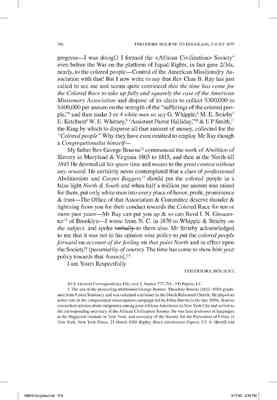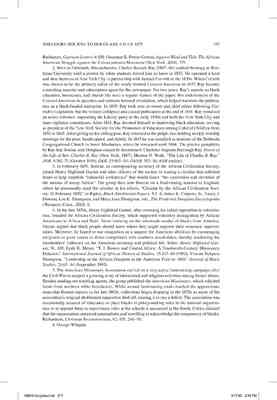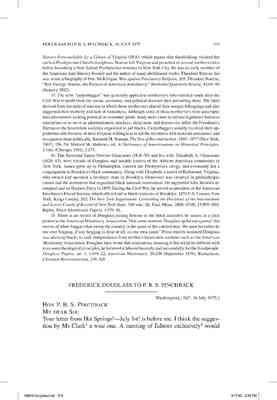Pages
page_0001
THEODORE BOURNE1The son of the pioneering abolitionist George Bourne, Theodore Bourne (1822–1910) graduated from Union Seminary and was ordained a minister in the Dutch Reformed Church. He played an active role in the compensated emancipation campaign led by Elihu Burritt in the late 1850s. Bourne researched opinion about emigration among poor African Americans in New York City and served as the corresponding secretary of the African Civilization Society. He was later professor of languages at the Huguenot Institute in New York, and secretary of the Society for the Prevention of Crime in New York. New York Times, 23 March 1910; Ripley, Black Abolitionist Papers, 5: 3–6; Merrill and Ruchames, Garrison Letters, 6: 108; Ousmane K. Power-Greene, Against Wind and Tide: The African American Struggle against the Colonizationist Movement (New York, 2014), 175. TO FREDERICK DOUGLASS
New York[, N.Y.] 9 July [1875.]
232 WEST 11TH ST
FREDERICK DOUGLASS ESQ
DEAR SIR
I dropped you a hasty line yesterday to say I forwarded two of Mr Ray’s2Born in Falmouth, Massachusetts, Charles Bennett Ray (1807–86) studied theology at Wesleyan University until a protest by white students forced him to leave in 1832. He operated a boot and shoe business in New York City in partnership with Samuel Cornish in the 1830s. When Cornish was chosen to be the primary editor of the newly formed Colored American in 1837, Ray became a traveling reporter and subscription agent for the newspaper. For two years, Ray’s reports on black education, businesses, and church life were a regular feature of the paper. His endorsement of the Colored American in speeches and sermons boosted circulation, which helped maintain the publication as a black-funded enterprise. In 1839, Ray took over as owner and chief editor following Cornish’s resignation, but the venture collapsed and ceased publication at the end of 1841. Ray remained an active reformer, supporting the Liberty party in the early 1840s and both the New York City and state vigilance committees. After 1841, Ray devoted himself to improving black education, serving as president of the New York Society for the Promotion of Education among Colored Children from 1851 to 1865. After giving up his editing post, Ray returned to the pulpit, too, holding weekly worship meetings for the poor, handicapped, and elderly. In 1845 he was installed as minister of the Bethesda Congregational Church in lower Manhattan, where he remained until 1868. The precise pamphlets by Ray that Bourne sent Douglass cannot be determined. Charlotte Augusta Burrough Ray, Sketch of the Life of Rev. Charles B. Ray (New York, 1887); Monroe N. Work, “The Life of Charles B. Ray,” JNH, 4: 361–71 (October 1919); DAB, 15: 403–04; DANB, 515–16; ANB (online). pamphlets to you and to enclose one (old) copy of a circular address which I issued in London in 1859 intended to arouse an interest for Africa.3In February 1859, Bourne, as corresponding secretary of the African Civilization Society, joined Henry Highland Garnet and other officers of the society in issuing a circular that solicited funds to help establish “industrial settlements” that would foster “the conversion and elevation of the nations of sunny Africa.” The group then sent Bourne on a fund-raising mission to England, where he presumably used the circular in his efforts. “Circular by the African Civilization Society, 16 February 1859,” in Ripley, Black Abolitionist Papers, 5: 3–6; James L. Conyers, Jr., Nancy J. Dawson, Lee E. Thompson, and Mary Joan Thompson, eds., The Frederick Douglass Encyclopedia (Westport, Conn., 2010), 6. Thousands of Spanish Portuguese French British & American Merchants for 300 years have grown rich on the Palm Oil, Ivory, Gold, Diamonds, Cotton &c &c of Africa and I thought I could call the attention of Anglo Africans to that great field for discovery ambition of doing good, and
page_0002
progress—I was doing[.] I formed the <African Civilization> Society4In the late 1850s, Henry Highland Garnet, after reversing his initial opposition to colonization, founded the African Civilization Society, which supported voluntary immigration by African Americans to Africa and Haiti. Never insisting on the wholesale exodus of blacks from America, Garnet argued that black people should move where they might improve their economic opportunities. Moreover, he hoped to use emigration as a support for American abolition by encouraging emigrants to grow cotton in direct competition with southern slaveholders, thereby weakening the slaveholders’ influence on the American economy and political life. Schor, Henry Highland Garnet, 91, 103; Lysle E. Meyer, “T. J. Bowen and Central Africa: A Nineteenth-Century Missionary Delusion,” International Journal of African Historical Studies, 15: 247–60 (1982); Vincent Bakpetu Thompson, “Leadership in the African Diaspora in the Americas Prior to 1860,” Journal of Black Studies, 24: 63–64 (September 1993). even before the War on the platform of Equal Rights, in fact gave 2/3ds, nearly, to the colored people—Control of the American Miss[iona]ry Association with that! But I now write to say that Rev Chas B. Ray has just called to see me and seems quite convinced that the time has come for the Colored Race to take up fully and squarely the case of the American Missionary Association and dispose of its claim to collect $300,000 to $400,000 per annum on the strength of the “sufferings of the colored people,”5The American Missionary Association carried on a very active fund-raising campaign after the Civil War to support a growing array of educational and religious activities among former slaves. Besides sending out traveling agents, the group published the American Missionary, which solicited funds from northern white benefactors. While annual fund-raising totals reached the approximate sums that Bourne reports in the late 1860s, collections began dropping in the 1870s as many of the association’s original abolitionist supporters died off, causing it to run a deficit. The association was occasionally accused of reluctance to place blacks in policy-making roles in the national organization or to appoint them to supervisory roles at the schools it sponsored in the South. Critics claimed that the organization remained paternalistic and unwilling to acknowledge the competency of blacks. Richardson, Christian Reconstruction, 92–105, 246–50. and then make 3 or 4 white men so say G. Whipple,6George Whipple. M. E. Strieby7Michael Epaphras Strieby (1815–99) graduated from Oberlin College in 1838. Ordained a Congregational minister, he served in churches in Mount Vernon, Ohio, and Syracuse, New York, before accepting the position of corresponding secretary of the American Missionary Association in 1864. In that post, he wrote many articles and books to support his organization’s work among African Americans in the South. In politics, Strieby endorsed Andrew Johnson’s impeachment and the passage of the Fifteenth Amendment. Occasionally losing patience with the association’s teachers, Strieby was characterized by one historian as “a competent, and sometimes erratic, administrator.” New York Outlook, 25 March 1899; Richardson, Christian Reconstruction, 90–91, 136, 224, 253–54. E. Ketchum8Edgar Ketchum (1811–82) replaced the veteran abolitionist Lewis Tappan as the treasurer of the American Missionary Association in 1865. Ketchum was a prominent New York City attorney and a former collector of internal revenue for the New York district; his house was targeted by New York draft rioters in July 1863. He delegated most of the actual accounting to his assistant, William E. Whiting. Although considerably less invested in the management of the association than Tappan, Ketchum nevertheless stayed in his post until 1879. Clara Merritt DeBoer, His Truth Is Marching On: African Americans Who Taught the Freedmen for the American Missionary Association, 1861–1877 (1995; New York, 2016), 102; Lyman Horace Weeks, Prominent Families of New York: Being an Account in Biographical Form of Individuals and Families Distinguished as Representatives of the Social, Professional and Civic Life of New York City (New York, 1897), 338–39; Richardson, Christian Reconstruction, 77, 186. W. E. Whitney,9Bourne probably means William E. Whiting (1803–78), a ruling elder of a Dutch Reformed church in Brooklyn, New York. Whiting, a longtime abolitionist ally of Lewis Tappan, sat on the executive committee of the American and Foreign Anti-Slavery Society (1844–55) and was its treasurer (1846–55). When that group went defunct, he held similar offices in the American Abolition Society. Whiting served as an executive committee member of the American Missionary Association from its start in 1846 and was later its assistant treasurer (1865–76). In the latter role, Whiting paid salaries and ordered supplies for missionaries across the South. Richardson, Christian Reconstruction, 91, 179, 283. “Assistant Pastor Halliday,”10Born in Morristown, New Jersey, Samuel Byram Halliday (1812–97) graduated from the Bloomfield Academy and undertook work for tract societies in New York and Rhode Island. In the 1850s, Halliday worked as an agent of the Female Guardian Society and as superintendent of the Five Points House of Industry in New York City. Ordained a Congregationalist minister in 1863, he engaged in missionary work among New York City’s poor until becoming the assistant pastor of Henry Ward Beecher’s Plymouth Church in Brooklyn. After Beecher’s death, Halliday joined Lyman Abbott in writing a flattering biography of the controversial minister. Halliday was an executive committee member of the American Missionary Association. New York Times, 9 July 1897; American Missionary, 42: 116 (May 1888); The Congregational Year-Book, 1898 (Boston, 1898), 23; Samuel Byram Halliday, The Lost and Found: Or, Life among the Poor (New York, 1860); Julie Miller, Abandoned: Foundlings in Nineteenth-Century New York City (New York, 2008), 90–94. & E P Smith,11Edward Parmelee Smith (1827–76) was born in South Britain, Connecticut, and graduated from Dartmouth College and Yale Theological Seminary. After serving as a Congregationalist pastor in Pepperell, Massachusetts, he joined the U.S. Sanitary Commission during the Civil War and ministered to Union soldiers. After the war, as a field secretary for the American Missionary Association in Cincinnati, Smith was put in charge of establishing schools in the southwestern states. A Republican, he served the Grant administration as U.S. commissioner of Indian Affairs (1873–75); though charged with corruption, he was exonerated. While in that position, Smith was elected president of Howard University, but died on a tour of American Missionary Association stations in Africa before he could assume the post. New York Times, 16 August 1876; Richardson, Christian Reconstruction, 81, 91, 99, 124. the Ring by which to disperse all that amount of money, collected for the “Colored people” Why they have even omitted to employ Mr Ray though a Congregationalist himself—
My father Rev George Bourne12The English immigrant George Bourne (1780–1845) settled in Virginia, where he became a Presbyterian minister and an early questioner of the morality of slaveholding. His preaching led to his defrocking by the local presbytery in 1815. In response, he wrote and had printed The Book and Slavery Irreconcilable by a Citizen of Virginia (1816), which argues that slaveholding violated the earliest Presbyterian Church disciplines. Bourne left Virginia and preached in several northern cities before becoming a New School Presbyterian minister in New York City. He was an early member of the American Anti-Slavery Society and the author of many abolitionist works. Theodore Bourne, his son, wrote a biography of him. McKivigan, War against Proslavery Religion, 205; Theodore Bourne, “Rev. George Bourne, the Pioneer of American Antislavery,” Methodist Quarterly Review, 42: 68–90 (January 1882). commenced the work of Abolition of Slavery in Maryland & Virginia 1805 to 1815, and then at the North till 1845 He devoted all his spare time and means to the great contest without any reward. He certainly never contemplated that a class of professional Abolitionists and Carpet Baggers13The term “carpetbagger” was generally applied to northerners who traveled south after the Civil War to profit from the social, economic, and political disorder then prevailing there. The label derived from the style of suitcase in which these northerners placed their meager belongings and also suggested their mobility and lack of rootedness. Although some of these northerners were unscrupulous adventurers seeking political or economic profit, many more came to initiate legitimate business enterprises or to serve as administrators, teachers, clergymen, and doctors for either the Freedmen’s Bureau or the benevolent societies organized to aid blacks. Carpetbaggers usually received their opprobrious title because of their frequent willingness to aid the freedmen with material sustenance and to organize them politically. Kenneth M. Stampp, The Era of Reconstruction, 1865–1877 (New York, 1965), 156–59; Mitford M. Mathews, ed., A Dictionary of Americanisms on Historical Principles, 2 vols. (Chicago, 1951), 1: 273. should put the colored people in a false light North & South and when half a million per annum was raised for them, put only white men into every place of honor, profit, prominence & trust—The Office of that Association & Committee deserve thunder & lightning from you for their conduct towards the Colored Race for ten or more past years—Mr Ray can put you up & so can Revd I. N. Gloucester14The Reverend James Newton Gloucester (1818–90) and his wife, Elizabeth A. Gloucester (1820–83), were friends of Douglass and notable leaders of the African American community in New York. James grew up in Philadelphia, entered the Presbyterian clergy, and eventually led a congregation in Brooklyn’s black community. Along with Elizabeth, a native of Richmond, Virginia, who owned and operated a furniture store in Brooklyn, Gloucester was involved in philanthropic causes and the movement that organized black national conventions. He supported John Brown’s attempted raid on Harpers Ferry in 1859. During the Civil War, he served as president of the American Freedmen’s Friend Society, which offered aid to black residents of Brooklyn. 1870 U.S. Census, New York, Kings County, 265; The New York Supplement: Containing the Decisions of the Intermediate and Lower Courts of Record of New York State, 300 vols. (St. Paul, Minn., 1888–1938), 15: 899–900; Ripley, Black Abolitionist Papers, 4: 379–81. of Brooklyn—I wrote from N. C. in 1870 to Whipple & Strieby on the subject, and spoke verbally to them also. Mr Strieby acknowledged to me that it was not in his opinion wise policy to put the colored people forward on account of the feeling on that point North and in effect upon the Society!! (pecuniarily of course). The time has come to show him your policy towards that Assocn[.]15There is no record of Douglass joining Bourne or the black ministers he names in a joint protest to the American Missionary Association. That same summer, Douglass spoke out against “the swarm of white beggars that sweep the country in the name of the colored race. We must hereafter do our own begging, if any begging is done at all, on our own name.” Press reports assumed Douglass was advising blacks to seek independence from northern benevolent societies such as the American Missionary Association. Douglass later wrote that association, assuring it that while he differed with it on some theological principles, he believed it labored honestly and successfully for the freedpeople. Douglass Papers, ser. 1, 4: 419–22; American Missionary, 20: 208 (September 1876); Richardson, Christian Reconstruction, 249, 319.
I am Yours Respectfully
THEODORE BOURNE
ALS: General Correspondence File, reel 2, frames 777–79L, FD Papers, LC.




